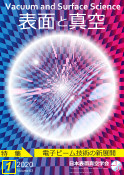Volume 63, Issue 12
Special Feature : Plasma-induced Interface Reaction and Surface Science
Displaying 1-11 of 11 articles from this issue
- |<
- <
- 1
- >
- >|
Preface
-
Article type: Preface
2020 Volume 63 Issue 12 Pages 613
Published: December 10, 2020
Released on J-STAGE: December 10, 2020
Download PDF (352K)
Special Feature : Plasma-induced Interface Reaction and Surface Science
-
Article type: Introduction
2020 Volume 63 Issue 12 Pages 614-615
Published: December 10, 2020
Released on J-STAGE: December 10, 2020
Download PDF (279K) -
Article type: Current Topics
2020 Volume 63 Issue 12 Pages 616-622
Published: December 10, 2020
Released on J-STAGE: December 10, 2020
Download PDF (3031K) -
Article type: Current Topics
2020 Volume 63 Issue 12 Pages 623-628
Published: December 10, 2020
Released on J-STAGE: December 10, 2020
Download PDF (3502K) -
Article type: Current Topics
2020 Volume 63 Issue 12 Pages 629-634
Published: December 10, 2020
Released on J-STAGE: December 10, 2020
Download PDF (1317K) -
Article type: Current Topics
2020 Volume 63 Issue 12 Pages 635-640
Published: December 10, 2020
Released on J-STAGE: December 10, 2020
Download PDF (1063K) -
Article type: Current Topics
2020 Volume 63 Issue 12 Pages 641-648
Published: December 10, 2020
Released on J-STAGE: December 10, 2020
Download PDF (2722K) -
 Article type: Current Topics
Article type: Current Topics
2020 Volume 63 Issue 12 Pages 649-655
Published: December 10, 2020
Released on J-STAGE: December 10, 2020
Science Café
-
Article type: Science Café
2020 Volume 63 Issue 12 Pages 656-659
Published: December 10, 2020
Released on J-STAGE: December 10, 2020
Download PDF (2242K)
Research Abroad
-
Article type: Science Café
2020 Volume 63 Issue 12 Pages 660-662
Published: December 10, 2020
Released on J-STAGE: December 10, 2020
Download PDF (1663K)
News & Trends
-
Article type: News & Trends
2020 Volume 63 Issue 12 Pages 663
Published: December 10, 2020
Released on J-STAGE: December 10, 2020
Download PDF (319K)
- |<
- <
- 1
- >
- >|






